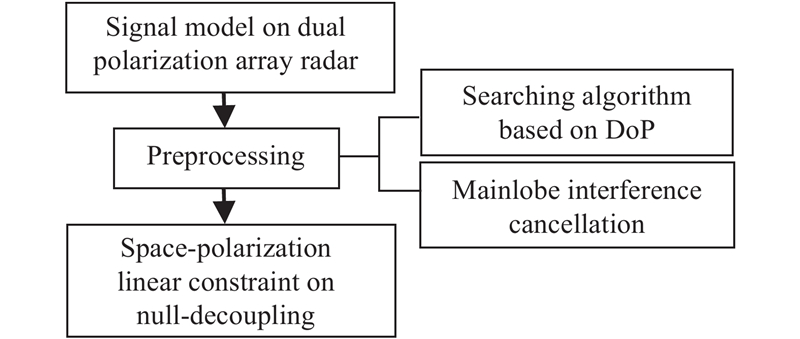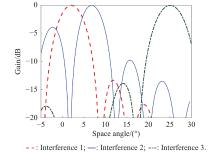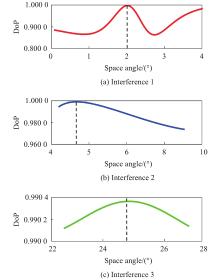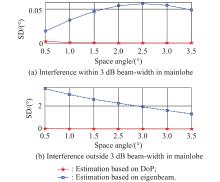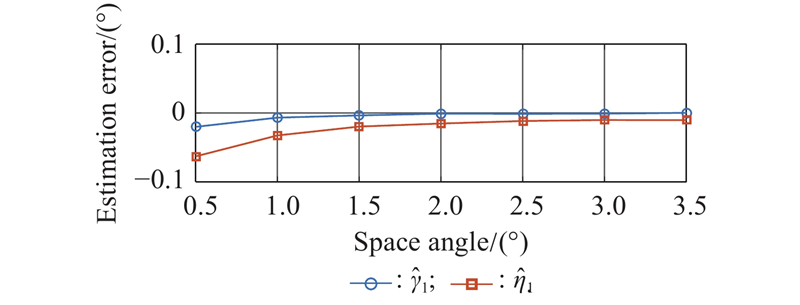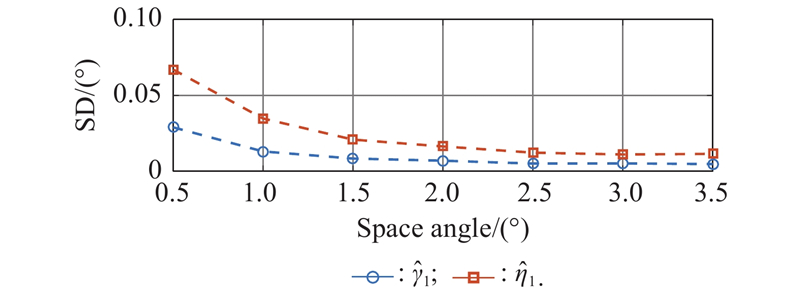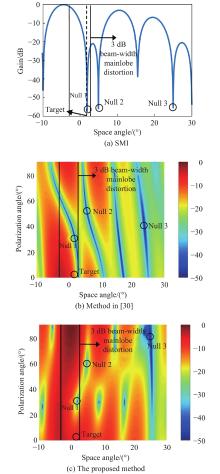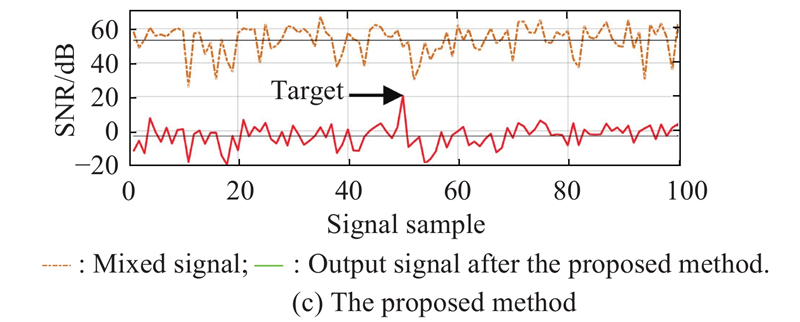| 1 |
YU K B, MURROW D J Adaptive digital beamforming for angle estimation in jamming. IEEE Trans. on Aerospace and Electronic Systems, 2001, 37 (2): 508- 523.
doi: 10.1109/7.937465
|
| 2 |
NICKEL U, CHAUMETTE E, LARZABAL P Estimation of extended targets using the generalized monopulse estimator: extension to a mixed target model. IEEE Trans. on Aerospace and Electronic Systems, 2013, 49 (3): 2085- 2096.
|
| 3 |
CHEN X Z, SHU T, YU K B, et al Enhanced ADBF architecture for monopulse angle estimation in multiple jammings. IEEE Antennas and Wireless Propagation Letters, 2017, 16, 2684- 2687.
doi: 10.1109/LAWP.2017.2740958
|
| 4 |
LI R F, WANG Y L, WAN S H Research of reshaping adapted pattern under mainlobe interference conditions. Modern Radar, 2002, 24 (3): 50- 55.
|
| 5 |
SUN C W, TAO H H Mainlobe maintenance using shrinkage estimator method. IET Signal Processing, 2018, 12 (2): 169- 173.
doi: 10.1049/iet-spr.2016.0691
|
| 6 |
QIAN J H, HE Z S, JIA F D, et al. Mainlobe interference suppression in adaptive array. Proc. of the 13th IEEE International Conference on Signal Processing, 2016: 470−474.
|
| 7 |
LU L J, LIAO Y P. Improved algorithm of mainlobe interference suppression based on eigen-subspace. Proc. of the International Conference on Communication and Signal Processing, 2016: 133−137.
|
| 8 |
QIAN J H, HE Z S Mainlobe interference suppression with eigenprojection algorithm and similarity constraints. Electronics Letters, 2016, 52 (3): 228- 230.
doi: 10.1049/el.2015.2951
|
| 9 |
MOHAMMADZADEH S, NASCIMENTO V H. Maximum entropy-based interference-plus-noise covariance matrix reconstruction for robust adaptive beamforming. IEEE Signal Processing Letters, 2020. DOI: 10.1109/LSP.2020.2994527.
|
| 10 |
YANG X P, ZHANG Z A, ZENG T Mainlobe interference suppression based on eigen-projection processing and covariance matrix reconstruction. IEEE Antennas and Wireless Propagation Letters, 2014, 13, 1369- 1372.
doi: 10.1109/LAWP.2014.2339224
|
| 11 |
AI X Y, GAN L Robust adaptive beamforming with subspace projection and covariance matrix reconstruction. IEEE Access, 2019, 7, 102149- 102159.
doi: 10.1109/ACCESS.2019.2930750
|
| 12 |
ZHANG X, LIU S, YAN F G, et al. Robust adaptive beamforming based on covariance matrix reconstruction against steering vector mismatch. Proc. of the IEEE/CIC International Conference on Communications, 2019: 283−286.
|
| 13 |
ZHENG Z, ZHENG Y, WANG W Q, et al Covariance matrix reconstruction with interference steering vector and power estimation for robust adaptive beamforming. IEEE Trans. on Vehicular Technology, 2018, 67 (9): 8495- 8503.
doi: 10.1109/TVT.2018.2849646
|
| 14 |
YU K B. Mainlobe cancellation, orthogonal nulling and product patterns. Proc. of the IEEE International Symposium on Phased Array Systems and Technology, 2016: 1−7.
|
| 15 |
CHEN X Z, SHU T. Multiple jamming cancellation using adaptive subarray DBF for monopulse angle estimation. Proc. of the IEEE International Symposium on Phased Array Systems Technology, 2016: 1−6.
|
| 16 |
ELAYAPERUMAL S, HARI K V S. Optimal irregular subarray design for adaptive jammer suppression in phased array radar. Proc. of the IEEE International Symposium on Phased Array Systems and Technology, 2019: 1−7.
|
| 17 |
SRIYANANDA M G S, JOTSENSALO J, HAMMALAINEN T Blind source separation for OFDM with filtering colored noise and jamming signal. Journal of Communications and Networks, 2012, 14 (4): 410- 417.
doi: 10.1109/JCN.2012.6292247
|
| 18 |
DUAN Y L, ZHANG H Noisy blind signal-jamming separation algorithm based on VBICA. Wireless Personal Communications, 2014, 74 (2): 307- 324.
doi: 10.1007/s11277-013-1286-6
|
| 19 |
LI J, ZHANG H, ZHANG J Fast adaptive BSS algorithm for independent/dependent sources. IEEE Communications Letters, 2016, 11 (20): 2221- 2224.
|
| 20 |
ZHOU B L, LI R F, LIU W J, et al A BSS-based space–time multi-channel algorithm for complex-jamming suppression. Digital Signal Processing, 2019, 87, 86- 103.
doi: 10.1016/j.dsp.2019.01.007
|
| 21 |
SHI L F, REN B, MA J Z, et al Recent developments of radar anti-interference techniques with polarimetry. Modern Radar, 2016, 38 (4): 1- 7.
|
| 22 |
XU Z H, XIONG Z Y, CHANG Y L Optimal receiving polarization obtained through solving unitary quadratic equation. IEEE Antennas and Wireless Propagation Letters, 2015, 14 (2): 198- 200.
|
| 23 |
YANG Z X, LI F Z, LI F. A novel method of adaptive polarization canceller for interference cancellation. Proc. of the International Conference on Microwave and Millimeter Wave Technology, 2019: 1−3.
|
| 24 |
MA J Z, SHI L F, LI Y Z, et al Angle estimation of extended targets in main-lobe interference with polarization filtering. IEEE Trans. on Aerospace and Electronic Systems, 2017, 53 (1): 169- 189.
doi: 10.1109/TAES.2017.2649783
|
| 25 |
MA J Z, SHI L F, LI Y Z, et al Angle estimation with polarization filtering: a single snapshot approach. IEEE Trans. on Aerospace and Electronic Systems, 2018, 54 (1): 257- 268.
doi: 10.1109/TAES.2017.2756218
|
| 26 |
WANG X S, CHANG Y L, DAI D H Band characteristics of SINR polarization filter. IEEE Trans. on Antennas and Propagation, 2007, 55 (4): 1148- 1154.
doi: 10.1109/TAP.2007.893402
|
| 27 |
MAO X P, LIU A J, HOU H J, et al Oblique projection polarisation filtering for interference suppression in high-frequency surface wave radar. IET Radar, Sonar and Navigation, 2012, 6 (2): 71- 80.
doi: 10.1049/iet-rsn.2011.0175
|
| 28 |
XU J W, WANG C H, LIAO G S, et al Sum and difference beamforming for angle-Doppler estimation with stap-based radars. IEEE Trans. on Aerospace and Electronic Systems, 2016, 52 (6): 2825- 2837.
doi: 10.1109/TAES.2016.150728
|
| 29 |
SHI L F, REN B, LI Y Z, et al. Joint filtering scheme of multistation GSM interference for UHF-band radar. Proc. of the IEEE International Conference on Signal Processing, Communications and Computing, 2013: 1−5.
|
| 30 |
XU Z H, WANG X S, XIAO S P, et al Filtering performance of polarization sensitive array: completely polarized case. Acta Electronica Sinica, 2004, 32 (8): 1310- 1313.
|
| 31 |
MAO X P, YANG Y L, HONG H, et al Multi-domain collaborative filter for interference suppressing. IET Signal Processing, 2016, 10 (9): 1157- 1168.
doi: 10.1049/iet-spr.2016.0140
|
| 32 |
ZHOU B L, WANG Y L, LI R F, et al A blind range-direction estimation method under the mainlobe smart jamming condition. Acta Electronica Sinica, 2019, 47 (9): 1819- 1829.
|
| 33 |
HUANG S B, YU L, HAN F J, et al. Adaptive beamforming algorithm for interference suppression based on partition PSO. Proc. of the 7th IEEE Annual Information Technology, Electronics and Mobile Communication Conference, 2016: 1−5.
|
 ), Jiazhi MA(
), Jiazhi MA( ), Longfei SHI*(
), Longfei SHI*( ), Yuan QUAN(
), Yuan QUAN( )
)

